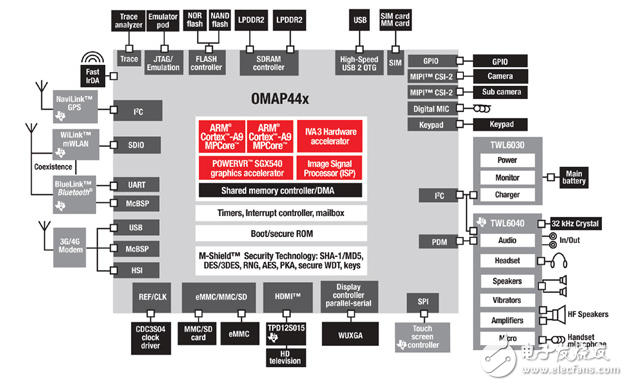
资料下载

便携式设计的多核解决方案
便携式设计的多核解决方案
一开始有手机,而且很好——事实上,它们是砖块的大小和重量,只能做一件事:打电话。今天的手机是二十一世纪的微型计算机,能够运行无数的“应用程序”,流高清视频和高质量的音频,捕捉和处理12万像素的图片,并仍然打电话。
穆尔定律尽管如此,但对于单个处理器来说,这是一个很大的问题,尤其是一个需要在很长一段时间内从一个小电池进行操作的处理器。手机早已使用独立的应用处理器来从主处理器上卸载工作。然而,在一个低功耗的双核心的big.little方法–和NXP公司的ARM的它实施近期出台(M4 / M0)嵌入式单片机–移动非对称多核处理器(AMPS)在其他便携式设备将很快从生态位移动到主流。

Texas Instruments’ OMAP and DaVinci
Texas Instruments’ OMAP™ SoCs have long been the dominant applications processors in cellular handsets. Since streaming video and audio are best handled by a DSP in the data path, OMAP SoCs all combine a general-purpose ARM® processor with a TI DSP.
The original 130 nm OMAP 1 family – such as the OMAP5912ZZG – paired a 192 MHz ARM926EJ-S™ with a TMS320C55x™ DSP core. The internal bus structure – one program bus, three data read buses, two data write buses, and additional buses for peripheral and DMA activity – efficiently enabled the DSP to perform up to three data reads and two data writes in a single cycle for relatively high-speed video and image processing.
声明:本文内容及配图由入驻作者撰写或者入驻合作网站授权转载。文章观点仅代表作者本人,不代表电子发烧友网立场。文章及其配图仅供工程师学习之用,如有内容侵权或者其他违规问题,请联系本站处理。 举报投诉
- 相关下载
- 相关文章





